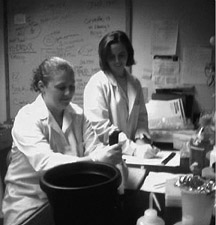Reproducing and Developing in a Sea of Pollutants: Killifish Adaptation in New Bedford Harbor
by Tracey Crago, Woods Hole Sea GrantKillifish. Though the name might evoke images of a malevolent finned creature, this small saltwater fish, common to Atlantic coast tidal creeks, harbors, and estuaries, is harmless. In New Bedford Harbor, killifish (Fundulus heteroclitus) are the recipients, not the source, of misfortune, exposed to environmental chemicals, heavy metals, and a plethora of other pollutants. Mysteriously, these resilient fish have not been killed off; in fact, they thrive in the harbor's veritable chemical soup.
"Killifish are so abundant in New Bedford Harbor you can walk on them,' says Gloria Callard, quoting a colleague. Callard, an endocrinologist at Boston University, has for years been studying the effects on fish of estrogen-like compounds found in the marine environment.

Such compounds persist in many polluted environments, where they can accumulate in animals, says Callard. These pollutants, also referred to as environmental estrogens, are able to mimic or block critical reproductive processes that normally are controlled by hormonal estrogen. They belong to a category of compounds known as endocrine-disrupting chemicals (EDCs). Short-term effects on fish exposed to estrogen-like EDCs in the laboratory include abnormal development, infertility, and low reproductive fitness, explains Callard. She says even "a single low-dose, transient exposure can change the course of development of an individual animal and result in lifelong defects.' Yet the long-term effects on animals living generation after generation in polluted natural environments are less clear.
 Sarah Rothberg Greytak (foreground) is studying killifish genes to learn how these fish have survived
for generations in New Bedford Harbor (above).
Sarah Rothberg Greytak (foreground) is studying killifish genes to learn how these fish have survived
for generations in New Bedford Harbor (above).
Callard's graduate student, Sarah Rothberg Greytak, is hoping to change that. Her Ph.D. thesis on the long-term impacts of pollutant exposure on reproduction and development of New Bedford Harbor killifish populations is funded in part through a Woods Hole Sea Grant-sponsored environmental technology grant.
In New Bedford Harbor, high levels of chemical pollutants have existed over generations. They got there as industrial waste, discharged into the harbor by manufacturers of electrical devices from 1940 to the late-1970s. "If killifish from clean environments were brought to New Bedford Harbor, they would die,' says Callard. "Bottom line: not only do these fish survive in a horrible, polluted environment, but they continue to reproduce. What we know from earlier studies is that the New Bedford Harbor killifish evolved a resistance to the toxic effects of pollutants. What we want to know is whether they have somehow evolved resistance to the endocrine disrupting effects of environmental estrogens.'
Callard explains that "when environmental chemicals act as estrogen mimics, they bind to the receptors in regulatory regions of estrogen target genes. By taking up a space on the gene, the estrogen mimic can interfere with normal estrogen action. "Exposing a fish, or any animal, to estrogen at the wrong time can perturb reproduction and development," says Callard.
Estrogen is a key hormone in fish reproduction, just as it is in humans. In fish, estrogen levels may vary by sex, population, and season. "Reproduction,' says Callard, 'requires a very delicate balance of many hormones, including estrogen." This study seeks to shed light on how New Bedford Harbor killifish maintain the right balance, in what Callard refers to as "a sea of inappropriate estrogen."
Callard and Rothberg Greytak hypothesize that, initially, when the New Bedford Harbor killifish were first exposed to the environmental chemicals, some of the fish failed to reproduce and died off. "But some,' reasons Callard, 'must have had genes or processes that allowed for adaptations that somehow neutralized the bad effects of environmental estrogens. Those with the alteration have survived with a resistant lineage. We are now [witnessing] the end result of an evolutionary process."
Getting at the mechanism of resistance or adaptation requires that researchers follow a systematic research approach comparing killifish from New Bedford Harbor with killifish from a clean environment (Scorton Creek, in Sandwich, Mass.). They cloned killifish genes to measure differences in gene activity by season, sex, and population in both embryos and adults from both locations. They also treated killifish embryos and adults to determine their sensitivity and responsiveness to estrogen.
Additionally, they are measuring other endpoints, including gonadal weight, appearance, and histology, to determine how "abnormal" the New Bedford Harbor killifish are, in terms of their reproductive status. "Given that they reproduce, we know that they're not that abnormal,' says Callard. Results confirmed slight histological differences between the two populations,as evidenced by variations in follicle and tubule sizes,and larger differences in gonadal sizes.
The researchers also analyzed the coding regions of the cloned killifish genes for population differences in polymorphisms, or selective sequence variations. While changes were apparent in gene expression levels, Callard says population differences in polymorphisms were not apparent.
"We took a quick look, superficially, and saw no obvious differences in the coding regions.' This, says Callard, "suggests that observed differences in [gene] expression reflect physiological, not genetic, adaptations. "But,' she cautions, "this doesn't mean there aren't polymorphisms in the upstream gene regulatory regions.' In fact, Callard and Rothberg Greytak will be looking in the regulatory region of the genes as a next step.
Really, we are just scratching the surface with this project,' says Callard, who is hopeful that another student, "just as devoted as Rothberg Greytak', will come along and continue the work. "The New Bedford Harbor fish are clearly estrogenized, and reproduction is impacted at several different points in both males and females. Yet these fish still reproduce. For every adaptation an organism must undergo, there is an associated cost,' says Callard. What that cost is, says Callard, "doesn't leap out at us...yet.'
